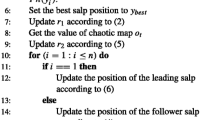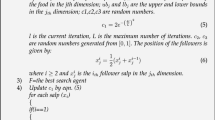Abstract
Recently, salp swarm algorithm (SSA) has emerged as a new population-based meta-heuristic technique in the area of optimization. It is mainly inspired from the navigating and foraging behaviour of salp swarms. The aforementioned algorithm weakness is stagnation in local optima and low convergence rate. To overcome these drawbacks, we proposed a new improved spiral chaotic salp swarm algorithm called ISC-SSA. Compared with original SSA, ISC-SSA includes logarithmic spiral mechanism incorporated with chaotic search methods capabilities to enhance further its performance. The functionality of ISC-SSA algorithm is firstly tested on 20 unimodal, multimodal and composite mathematical optimization problems with ten different chaotic maps to select the most appropriate one for ISC-SSA modification. Then, the algorithm is applied to solve several engineering optimization problems. The comparative experimental results with competitive metaheuristic algorithms reveal that ISC-SSA algorithm can generate the best solutions.













Similar content being viewed by others
References
Yang X-S (2010) Engineering optimization: an introduction with metaheuristic applications. Wiley
Yang X-S (2010) Nature-inspired metaheuristic algorithms. Luniver Press, Beckington
Holland JH (1992) Genetic algorithms. Sci Am 267:66–73
Koza JR, Koza JR (1992) Genetic programming: on the programming of computers by means of natural selection. MIT Press, Cambridge
Beyer H-G, Schwefel H-P (2002) Evolution strategies—a comprehensive introduction. Nat Comput 1:3–52
Storn R, Price K (1997) Differential evolution—a simple and efficient heuristic for global optimization over continuous spaces. J Glob Optim 11:341–359
Simon D (2008) Biogeography-based optimization. IEEE Trans Evol Comput 12:702–713
Dorigo M, Colorni A, Maniezzo V (1991) Distributed optimization by ant colonies. Elsevier, Amsterdam
Eberhart R, Kennedy J (1995) A new optimizer using particle swarm theory. In: MHS’95. Proceedings of the sixth international symposium on micro machine and human science. IEEE, pp 39–43
Karaboga D (2005) An idea based on honey bee swarm for numerical optimization. Technical report-tr06, Erciyes University, Engineering Faculty, Computer
Yang X-S (2010) Firefly algorithm, stochastic test functions and design optimisation. arXiv Prepr arXiv: 10031409
Askarzadeh A (2014) Bird mating optimizer: an optimization algorithm inspired by bird mating strategies. Commun Nonlinear Sci Numer Simul 19:1213–1228
Yang X-S (2010) A new metaheuristic bat-inspired algorithm. In: Nature inspired cooperative strategies for optimization (NICSO 2010). Springer, pp 65–74
Gandomi AH, Alavi AH (2012) Krill herd: a new bio-inspired optimization algorithm. Commun Nonlinear Sci Numer Simul 17:4831–4845
Mirjalili S, Mirjalili SM, Lewis A (2014) Grey wolf optimizer. Adv Eng Softw 69:46–61
Yang X-S, Deb S (2009) Cuckoo search via Lévy flights. In: 2009 World congress on nature & biologically inspired computing (NaBIC). IEEE, pp 210–214
Mirjalili S (2015) The ant lion optimizer. Adv Eng Softw 83:80–98
Mirjalili S (2015) Moth-flame optimization algorithm: a novel nature-inspired heuristic paradigm. Knowl Based Syst 89:228–249
Kaveh A, Farhoudi N (2013) A new optimization method: Dolphin echolocation. Adv Eng Softw 59:53–70
Mirjalili S, Lewis A (2016) The whale optimization algorithm. Adv Eng Softw 95:51–67
Harifi S, Khalilian M, Mohammadzadeh J, Ebrahimnejad S (2019) Emperor Penguins Colony: a new metaheuristic algorithm for optimization. Evol Intell 12:211–226
Mirjalili S, Gandomi AH, Mirjalili SZ et al (2017) Salp swarm algorithm: a bio-inspired optimizer for engineering design problems. Adv Eng Softw 114:163–191
Kirkpatrick S, Gelatt CD, Vecchi MP (1983) Optimization by simulated annealing. Science (80-) 220:671–680
Erol OK, Eksin I (2006) A new optimization method: big bang–big crunch. Adv Eng Softw 37:106–111
Webster B, Bernhard PJ (2003) A local search optimization algorithm based on natural principles of gravitation
Kaveh A, Talatahari S (2010) A novel heuristic optimization method: charged system search. Acta Mech 213:267–289
Rashedi E, Nezamabadi-Pour H, Saryazdi S (2009) GSA: a gravitational search algorithm. Inf Sci (Ny) 179:2232–2248
Alatas B (2011) ACROA: artificial chemical reaction optimization algorithm for global optimization. Expert Syst Appl 38:13170–13180
Formato RA (2007) Central force optimization: a new metaheuristic with applications in applied electromagnetics. Prog Electromagn Res 77:425–491
Du H, Wu X, Zhuang J (2006) Small-world optimization algorithm for function optimization. In: International conference on natural computation. Springer, pp 264–273
Hatamlou A (2013) Black hole: a new heuristic optimization approach for data clustering. Inf Sci (Ny) 222:175–184
Shah-Hosseini H (2011) Principal components analysis by the galaxy-based search algorithm: a novel metaheuristic for continuous optimisation. Int J Comput Sci Eng 6:132–140
Kaveh A, Khayatazad M (2012) A new meta-heuristic method: ray optimization. Comput Struct 112:283–294
Moghaddam FF, Moghaddam RF, Cheriet M (2012) Curved space optimization: a random search based on general relativity theory. arXiv Prepr arXiv: 12082214
Bairathi D, Gopalani D (2019) Numerical optimization and feed-forward neural networks training using an improved optimization algorithm: multiple leader salp swarm algorithm. Evol Intell. https://doi.org/10.1007/s12065-019-00269-8
Ahmed S, Mafarja M, Faris H, Aljarah I (2018) Feature selection using salp swarm algorithm with chaos. In: Proceedings of the 2nd international conference on intelligent systems, metaheuristics & swarm intelligence, pp 65–69
Sayed GI, Khoriba G, Haggag MH (2018) A novel chaotic salp swarm algorithm for global optimization and feature selection. Appl Intell 48:3462–3481
Kaveh A (2014) Advances in metaheuristic algorithms for optimal design of structures. Springer
Berliner LM (1992) Statistics, probability and chaos. Stat Sci 7(1):69–90
Schuster HG, Just W (2006) Deterministic chaos: an introduction. Wiley
Eubank S, Farmer D (1990) An introduction to chaos and randomness. In: 1989 lectures in complex systems. Proceedings: lectures, vol 2
Gharooni-fard G, Moein-darbari F, Deldari H, Morvaridi A (2010) Scheduling of scientific workflows using a chaos-genetic algorithm. Procedia Comput Sci 1:1445–1454
Gandomi AH, Yun GJ, Yang X-S, Talatahari S (2013) Chaos-enhanced accelerated particle swarm optimization. Commun Nonlinear Sci Numer Simul 18:327–340
Alatas B (2010) Chaotic harmony search algorithms. Appl Math Comput 216:2687–2699
Alatas B (2010) Chaotic bee colony algorithms for global numerical optimization. Expert Syst Appl 37:5682–5687
Saremi S, Mirjalili S, Lewis A (2014) Biogeography-based optimisation with chaos. Neural Comput Appl 25:1077–1097
Gandomi AH, Yang X-S, Talatahari S, Alavi AH (2013) Firefly algorithm with chaos. Commun Nonlinear Sci Numer Simul 18:89–98
Mingjun J, Huanwen T (2004) Application of chaos in simulated annealing. Chaos Solitons Fractals 21:933–941
Saremi S, Mirjalili SM, Mirjalili S (2014) Chaotic krill herd optimization algorithm. Procedia Technol 12:180–185
Gandomi AH, Yang X-S (2014) Chaotic bat algorithm. J Comput Sci 5:224–232
dos Santos CL, Mariani VC (2008) Use of chaotic sequences in a biologically inspired algorithm for engineering design optimization. Expert Syst Appl 34:1905–1913
Kaur G, Arora S (2018) Chaotic whale optimization algorithm. J Comput Des Eng 5:275–284
Tavazoei MS, Haeri M (2007) An optimization algorithm based on chaotic behavior and fractal nature. J Comput Appl Math 206:1070–1081
Ibrahim RA, Elaziz MA, Lu S (2018) Chaotic opposition-based grey-wolf optimization algorithm based on differential evolution and disruption operator for global optimization. Expert Syst Appl 108:1–27
Wang G-G, Guo L, Gandomi AH et al (2014) Chaotic krill herd algorithm. Inf Sci (Ny) 274:17–34
Arora S, Singh S (2017) An improved butterfly optimization algorithm with chaos. J Intell Fuzzy Syst 32:1079–1088
Banks J, Brooks J, Cairns G et al (1992) On Devaney’s definition of chaos. Am Math Mon 99:332–334
Fotiou A (2005) Deterministic chaos. MSc Univ London, Queen Mary Westf Coll Sch Math Sci
Heidari-Bateni G, McGillem CD (1994) A chaotic direct-sequence spread-spectrum communication system. IEEE Trans Commun 42:1524–1527
Yao X, Liu Y, Lin G (1999) Evolutionary programming made faster. IEEE Trans Evol Comput 3:82–102
Digalakis JG, Margaritis KG (2001) On benchmarking functions for genetic algorithms. Int J Comput Math 77:481–506
Liang J-J, Suganthan PN, Deb K (2005) Novel composition test functions for numerical global optimization. In: Proceedings 2005 IEEE swarm intelligence symposium, 2005. SIS 2005. IEEE, pp 68–75
Derrac J, García S, Molina D, Herrera F (2011) A practical tutorial on the use of nonparametric statistical tests as a methodology for comparing evolutionary and swarm intelligence algorithms. Swarm Evol Comput 1:3–18
Yang X-S (2012) Flower pollination algorithm for global optimization. In: International conference on unconventional computing and natural computation. Springer, pp 240–249
He Q, Wang L (2007) An effective co-evolutionary particle swarm optimization for constrained engineering design problems. Eng Appl Artif Intell 20:89–99
Coello CAC, Montes EM (2002) Constraint-handling in genetic algorithms through the use of dominance-based tournament selection. Adv Eng Inform 16:193–203
Zhang Z, Ding S, Jia W (2019) A hybrid optimization algorithm based on cuckoo search and differential evolution for solving constrained engineering problems. Eng Appl Artif Intell 85:254–268
Kannan BK, Kramer SN (1994) An augmented Lagrange multiplier based method for mixed integer discrete continuous optimization and its applications to mechanical design. J Mech Des 116:405–411
Author information
Authors and Affiliations
Corresponding author
Additional information
Publisher's Note
Springer Nature remains neutral with regard to jurisdictional claims in published maps and institutional affiliations.
Rights and permissions
About this article
Cite this article
Mokeddem, D. A new improved salp swarm algorithm using logarithmic spiral mechanism enhanced with chaos for global optimization. Evol. Intel. 15, 1745–1775 (2022). https://doi.org/10.1007/s12065-021-00587-w
Received:
Revised:
Accepted:
Published:
Issue Date:
DOI: https://doi.org/10.1007/s12065-021-00587-w




